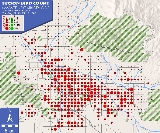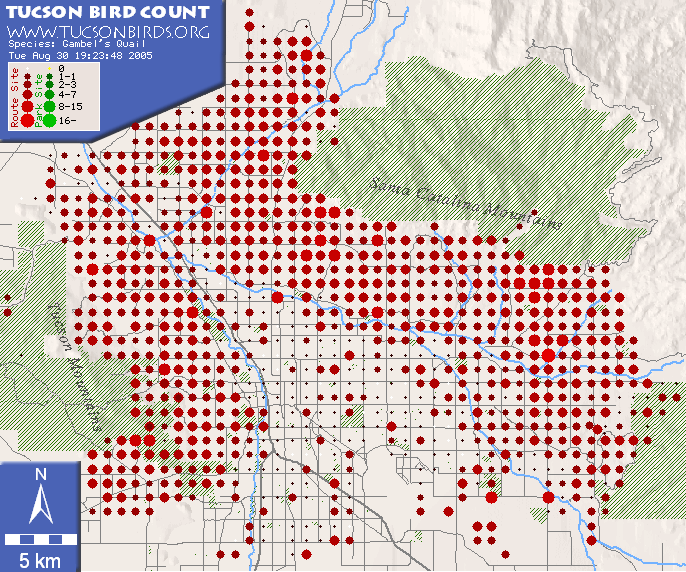
Tucson Bird Count
Encyclopedia
The Tucson Bird Count is a community-based program that monitors bird
populations in and around the Tucson, Arizona
, USA
metropolitan area. With nearly 1000 sites monitored annually, the Tucson Bird Count is among the largest urban biological monitoring programs in the world.
, drawing on the combined efforts of hundreds of volunteers. So that data are of suitable quality for scientific analysis and decisionmaking, all TBC volunteers are skilled birdwatchers; many are also professional field guides or biologists. TBC methods are similar to those employed by the North American Breeding Bird Survey
, although the TBC uses more closely spaced sites (one site per 1-km² square) over a smaller total area (approximately 1000 km²). For full details of TBC methods, see the TBC web page at tucsonbirds.org or Turner (2003). The TBC's spatially systematic monitoring is complemented by a TBC park monitoring program that surveys parks, watercourses, or other areas of particular interest multiple times throughout the year.
, in that they investigate how native species can be sustained in and around the places people live, work, and play. Researchers have also used TBC data to explore the extent to which urban humans are separated from nature (Turner et al. 2004)
Recently, the city of Ottawa, Canada has initiated an urban bird survey that is largely modeled on the Tucson Bird Count. The Ottawa Breeding Bird Count will conduct its inaugural season in 2007. By collaborating among cities, urban surveys like the Tucson Bird Count and the Ottawa Breeding Bird Count, will help researchers discover ways to create habitat for biodiversity in the places where people live and work.

 The Tucson Bird Count began in spring 2001 and is ongoing. As of summer 2005, the TBC had recorded 192,000 individual birds belonging to 212 distinct species
The Tucson Bird Count began in spring 2001 and is ongoing. As of summer 2005, the TBC had recorded 192,000 individual birds belonging to 212 distinct species
. About 115 of these species are known or suspected to breed in the Tucson area; the remainder are migrants (either to higher latitudes, or to higher elevations in nearby mountain ranges such as the Catalinas
) or vagrants.
Because the data are entered directly by participants into the Tucson Bird Count web site, results are publicly available on-line with little delay after observations are made. Among the project's more basic, yet striking results are distribution maps for species in the Tucson area. Many species show strong patterns with respect to development intensity, presence of various habitats, or other factors. For example, the non-native Rock Pigeon
, common in urban areas worldwide, is generally restricted to Tucson's urban core. In contrast, Gambel's Quail
, a characteristic species of Sonoran Desert
upland habitats, shows the inverse pattern, common near Tucson's periphery yet absent from most of the more heavily developed central portion of the city.
Bird
Birds are feathered, winged, bipedal, endothermic , egg-laying, vertebrate animals. Around 10,000 living species and 188 families makes them the most speciose class of tetrapod vertebrates. They inhabit ecosystems across the globe, from the Arctic to the Antarctic. Extant birds range in size from...
populations in and around the Tucson, Arizona
Arizona
Arizona ; is a state located in the southwestern region of the United States. It is also part of the western United States and the mountain west. The capital and largest city is Phoenix...
, USA
United States
The United States of America is a federal constitutional republic comprising fifty states and a federal district...
metropolitan area. With nearly 1000 sites monitored annually, the Tucson Bird Count is among the largest urban biological monitoring programs in the world.
Methods
Each spring, TBC participants collect data on bird abundance and distribution at hundreds of point count locations arrayed across the Tucson basin. The TBC is an example of citizen scienceCitizen science
Citizen science is a term used for the systematic collection and analysis of data; development of technology; testing of natural phenomena; and the dissemination of these activities by researchers on a primarily avocational basis...
, drawing on the combined efforts of hundreds of volunteers. So that data are of suitable quality for scientific analysis and decisionmaking, all TBC volunteers are skilled birdwatchers; many are also professional field guides or biologists. TBC methods are similar to those employed by the North American Breeding Bird Survey
Breeding Bird Survey
A breeding bird survey monitors the status and trends of bird populations. Data from the survey are an important source for the range maps found in field guides. The North American Breeding Bird Survey is a joint project of the United States Geological Survey and the Canadian Wildlife Service...
, although the TBC uses more closely spaced sites (one site per 1-km² square) over a smaller total area (approximately 1000 km²). For full details of TBC methods, see the TBC web page at tucsonbirds.org or Turner (2003). The TBC's spatially systematic monitoring is complemented by a TBC park monitoring program that surveys parks, watercourses, or other areas of particular interest multiple times throughout the year.
Uses of Data
Uses of Tucson Bird Count data include monitoring the status of the Tucson-area bird community over time, finding the areas and land-use practices that are succeeding at sustaining native birds, and investigating the ecology of birds in human-dominated landscapes. Tucson Bird Count results have led to scientific publications, informed Tucson-area planning, and contributed a variety of projects, from locating populations of imperiled species to estimating risk to humans from West Nile Virus. The TBC and several associated research projects are examples of reconciliation ecologyReconciliation ecology
Reconciliation ecology is the branch of ecology which studies ways to encourage biodiversity in human-dominated ecosystems. Michael Rosenzweig first articulated the concept in his book Win-Win Ecology, based on the theory that there is not enough area for all of Earth’s biodiversity to be saved...
, in that they investigate how native species can be sustained in and around the places people live, work, and play. Researchers have also used TBC data to explore the extent to which urban humans are separated from nature (Turner et al. 2004)
Recently, the city of Ottawa, Canada has initiated an urban bird survey that is largely modeled on the Tucson Bird Count. The Ottawa Breeding Bird Count will conduct its inaugural season in 2007. By collaborating among cities, urban surveys like the Tucson Bird Count and the Ottawa Breeding Bird Count, will help researchers discover ways to create habitat for biodiversity in the places where people live and work.
Basic Results


Species
In biology, a species is one of the basic units of biological classification and a taxonomic rank. A species is often defined as a group of organisms capable of interbreeding and producing fertile offspring. While in many cases this definition is adequate, more precise or differing measures are...
. About 115 of these species are known or suspected to breed in the Tucson area; the remainder are migrants (either to higher latitudes, or to higher elevations in nearby mountain ranges such as the Catalinas
Santa Catalina Mountains
The Santa Catalina Mountains, commonly referred to as the Catalina Mountains, are located north, and northeast of Tucson, Arizona, United States, on Tucson's north perimeter. The mountain range is the most prominent in the Tucson area, with the highest average elevation...
) or vagrants.
Because the data are entered directly by participants into the Tucson Bird Count web site, results are publicly available on-line with little delay after observations are made. Among the project's more basic, yet striking results are distribution maps for species in the Tucson area. Many species show strong patterns with respect to development intensity, presence of various habitats, or other factors. For example, the non-native Rock Pigeon
Rock Pigeon
The Rock Dove or Rock Pigeon, is a member of the bird family Columbidae . In common usage, this bird is often simply referred to as the "pigeon"....
, common in urban areas worldwide, is generally restricted to Tucson's urban core. In contrast, Gambel's Quail
Gambel's Quail
The Gambel's Quail, Callipepla gambelii, is a small ground-dwelling bird in the New World quail family. It inhabits the desert regions of Arizona, California, Colorado, New Mexico, Nevada, Utah, Texas, and Sonora; also New Mexico-border Chihuahua and the Colorado River region of Baja California...
, a characteristic species of Sonoran Desert
Sonoran Desert
The Sonoran Desert is a North American desert which straddles part of the United States-Mexico border and covers large parts of the U.S. states of Arizona and California and the northwest Mexican states of Sonora, Baja California, and Baja California Sur. It is one of the largest and hottest...
upland habitats, shows the inverse pattern, common near Tucson's periphery yet absent from most of the more heavily developed central portion of the city.
See also
- Australian Bird CountAustralian Bird CountThe Australian Bird Count was a project of the Royal Australasian Ornithologists Union . Following the first and successful Atlas of Australian Birds project, which led to the publication of a book on the distribution of Australian birds in 1984, it was suggested by Ken Rogers that the RAOU...
(ABC) - BioBlitzBioBlitzA BioBlitz, also written without capitals bioblitz, is an intense period of biological surveying in an attempt to record all the living species within a designated area. Groups of scientists, naturalists and volunteers conduct an intensive field study over a short, usually 24 hour, time...
("24-hour inventory") - Breeding Bird SurveyBreeding Bird SurveyA breeding bird survey monitors the status and trends of bird populations. Data from the survey are an important source for the range maps found in field guides. The North American Breeding Bird Survey is a joint project of the United States Geological Survey and the Canadian Wildlife Service...
- Christmas Bird CountChristmas Bird CountThe Christmas Bird Count is a census of birds in the Western Hemisphere, performed annually in the early Northern-hemisphere winter by volunteer birders...
(CBC) (in the Western Hemisphere)

